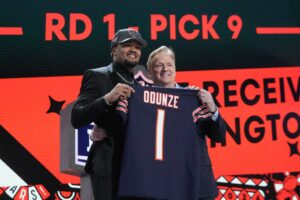After a 10-year hiatus from postseason action, Youngstown State is in the national spotlight again. After winning its fourth Division I-AA/FCS national championship in 1997, Youngstown State reached the playoffs just twice until this season. Now, the Penguins will look to win another title when they face James Madison on Jan. 7. The program experienced a great deal of change and turmoil after its peak, a scenario shared by the university’s president. Back where it all began, Jim Tressel can restart a legacy damaged by scandal.
Extraordinary Beginnings
An Ohio native, Tressel began his coaching career as a graduate assistant at Akron. From his debut season in 1975 through 1985, Tressel bounced around as an assistant for several programs. He only left Ohio once, from 1981-82, to coach quarterbacks at Syracuse. After three seasons as an assistant at Ohio State, he accepted the head coaching job at Youngstown State.
Youngstown, Ohio is something of a microcosm of the entire Rust Belt. A blue collar town in northeast Ohio, Youngstown has seen it’s fair share of issues throughout its existence. But there is one consistent presence in the city, one that’s been around since the late 1930s: Penguins football.
In 1985, under Bill Narduzzi, the Penguins finished 5-6 in the Ohio Valley Conference (OVC). The team faced immediate conflict after Narduzzi was replaced by Tressel. Narduzzi sued the university for wrongful discharge, while Tressel’s team floundered to a 2-9 record in his first season.
Glory Days
Fortunes changed for the Penguins by 1987. In his second season in charge, Tressel led Youngstown State to first place in the OVC and its third-ever playoff appearance. After a down year in 1988 (the same year Youngstown State elected to leave the OVC in favor of independent status), the Penguins rebounded with nine wins in 1989 and 11 wins in 1990, both seasons resulting in Division I-AA playoff berths.
The beginning of Youngstown State’s dominance came in 1991, Tressel’s sixth season, when it won the I-AA National Championship. In the next three seasons, YSU would play for the national title three more times, winning the latter two efforts. In the era spanning 1991-94, Tressel’s Penguins won 50 games, including their three title game victories.
Youngstown State took a jarring step back in 1995, finishing with a meager 3-8 record. The team bounced back with eight wins in 1996, but missed the playoffs for the second-straight year, the only such instance during Tressel’s tenure.
After its generally great success as an independent, Youngstown State joined the Gateway Conference (now the Missouri Valley Football Conference) in 1997. The addition of Youngstown State immediately paid dividends for the conference, as Tressel led the Penguins to another national title that year. Youngstown State’s four national championships are the third-most for any I-AA/FCS program, behind only Georgia Southern (six) and North Dakota State (five).
Tressel spent three more seasons at Youngstown State following the 1997 title, including two playoff berths and another title game appearance. A four-time national champion and three-time Chevrolet Coach of the Year, Tressel was ready to move on to the biggest job in his home state.
Columbus Calling
Ohio State is an iconic college football brand. From dotting the I to “The Game,” tradition abounds on Saturdays in the Horseshoe. Above all others, however, winning is the most important tradition at Ohio State. With six national championships in the 20th century, five of them coming under legendary coach Woody Hayes, victory is an expectation at Ohio State.
John Cooper soon wore out his welcome in Columbus. Despite winning more games than any coach in Ohio State history other than Hayes, Cooper was fired after losing the 2001 Outback Bowl to South Carolina. It wasn’t just the bowl loss that spelled doom for Cooper, however. A disappointing record versus Michigan, off-field and on-field disciplinary reasons also led to his dismissal. With Cooper’s ouster came the search for another coach.
It took just 16 days for Ohio State to find and announce their new head coach. The Buckeyes found their man without leaving the state of Ohio. Despite Tressel’s lack of head coaching experience in Division I-A, Ohio State athletics director Andy Geiger was comfortable with the hire.
“I measure the man and not the level,” Geiger said in a story originally published by the Fremont Tribune.
Tressel said he was humbled to be named coach at Ohio State, and his first season was certainly humbling for one of the country’s most decorated programs. The Buckeyes finished 7-5 in Tressel’s first season, concluding with another loss to South Carolina in the Outback Bowl. Despite the mediocre season, pieces were in place on the field for Ohio State’s quest to return to glory. Players like Craig Krenzel, Michael Jenkins and Will Smith combined to make a strong core for the Buckeyes’ future.
Back On Top
By adding Youngstown native Maurice Clarett in 2002, a title was within reach for Tressel and the Buckeyes. After a legendary and controversial 2003 Fiesta Bowl, Ohio State claimed the National Championship. The legacy of Jim Tressel continued to expand after his first Division I-A national title, his fifth overall.
After winning it all, it was nearly impossible to doubt Tressel as a legitimate I-A coach. From his first season in Columbus through 2009, Ohio State had just two seasons less than 10 wins: the aforementioned 2001 campaign and an 8-4 season in 2004, which ended in an Alamo Bowl victory.
Terrelle, Tattoos, Turmoil
The Tressel era in Columbus came to a screeching halt in December 2010. Five Buckeyes, including star quarterback Terrelle Pryor, were suspended for the first five games of the 2011 season in connection with a tattoo scandal, now known as “tattoogate.” The players were active for the Sugar Bowl at the conclusion of the 2010 season, a game Ohio State won. The immediate aftermath, however, is when Tressel’s coaching career fell apart.
… not so coincidentally, Terrelle Pryor’s tweet saying “I paid for my tattoos. Go Bucks” is missing…
— Eric Cash (@MrShift4) December 23, 2010
In February 2011, Tressel admitted he committed an NCAA violation to investigators. His prior knowledge of his players’ shady dealings with Edward Rife, a tattoo parlor owner under federal investigation, led to a suspension at the start of the 2011 season, concurrent to that of the aforementioned players.
In May that year, Tressel announced his resignation from Ohio State. In was an ironic and disgraceful end to a career for a man tasked with rebuilding Ohio State’s character after the tumultuous end to John Cooper’s tenure. Saddled with a five-year show-cause penalty, Tressel left Columbus under heavy scrutiny from the depressed and furious Buckeye nation.
Homecoming
After leaving Columbus, Tressel spent the 2011 season with the NFL’s Indianapolis Colts as a consultant. Despite committing his transgressions at the college level, the Colts still suspended Tressel several games to start the season. After his season with Indianapolis, he returned to college in 2012, but in a much different role.
The University of Akron is where Tressel started his coaching career in the mid-1970s, and it’s also where he began his career as an administrator. Putting his master’s degree in education to use, he was named the university’s vice president of strategic engagement in 2012. Despite his fame coming from on-field success, Akron president Luis Proenza stressed that Tressel would be an “asset” for the school.
Northeast Ohio Renaissance
In May 2014, Tressel announced he was leaving Akron to return to Youngstown State. He wasn’t announcing a return to the sidelines, however, rather the continuation of his career in academia. Facing a multi-million dollar deficit and a steep drop in enrollment, Youngstown State called on its biggest icon for help. After taking the school’s football program to new heights in the 1990s, university administration is hoping Tressel can do that same for the rest of the university.
Football success can lead to financial success at the FCS level, which means Youngstown State could have brighter days ahead. With Tressel on campus and a championship on the line, things are looking up for the Penguins. What’s necessary now for the program is consistency, a prolonged run at the top of Division I-FCS. Even though Tressel doesn’t run the team directly anymore (that responsibility belongs to another Division I-A/FBS castoff and Ohio native: Bo Pelini), his presence is a boost for the school’s overall profile, and likely for recruiting as well.
Jim Tressel is the President of Youngstown State & Bo Pelini is the coach. If you bet $1 on this in 2010 you’d now be #12 on the Forbes list
— Ryan Basford (@RyanBasford) December 18, 2016
Thirty years after beginning his head coaching career at Youngstown State, Jim Tressel is a changed man. He took a downtrodden Penguins team to unparalleled success in the 1990s. He won and lost it all on the biggest stage; the job he was humbled to have truly humbled him. He changed course, leaving the gridiron for office life. He returned to where it all began. Scandals are in the past, and he has a new attitude to go along with his new job. Now, with a national championship again in Youngstown State’s sights, he hopes to reach the top of the college football world once again, albeit from a different perspective.
Main Photo:






